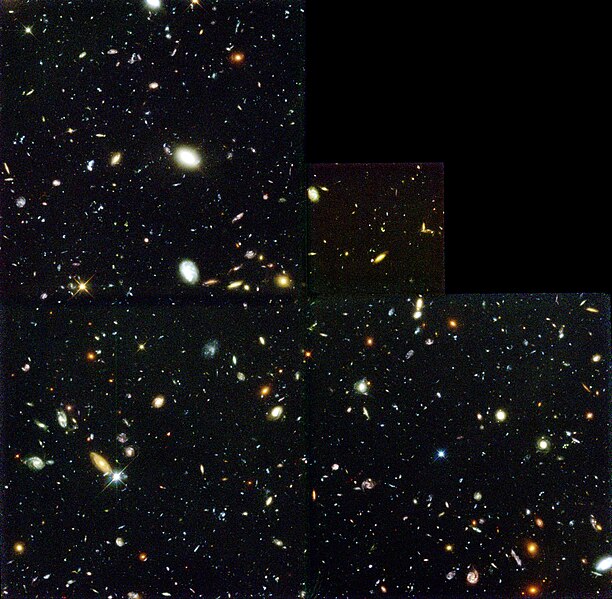Ummmmm - maybe the author didn't see the story where they pointed Hubble at an "empty" part of the sky and ended up detecting galaxies upon galaxies...... Not quite, There are millions of light years between those (and most) galaxies. They only appear close in the sky in that image because it's looking out to 12-13 billion light years. ONE light year, the *distance* light travels in a year at its fixed speed of 186,000 miles per second, works out to about 5.9 Trillion miles.
61 posted on
04/25/2018 12:16:29 PM PDT by
ETL
(Obama-Hillary, REAL Russia collusion! Uranium-One Deal, Missile Defense, Nukes. See my FR home page)
The Hubble Deep Field (HDF) is an image of a small region in the constellation Ursa Major, constructed from a series of observations by the Hubble Space Telescope. It covers an area about 2.6 arcminutes on a side, about one 24-millionth of the whole sky, which is equivalent in angular size to a tennis ball at a distance of 100 metres.[1]
The image was assembled from 342 separate exposures taken with the Space Telescope's Wide Field and Planetary Camera 2 over ten consecutive days between December 18 and December 28, 1995.[2][3]
The field is so small that only a few foreground stars in the Milky Way lie within it; thus, almost all of the 3,000 objects in the image are galaxies, some of which are among the youngest and most distant known. By revealing such large numbers of very young galaxies, the HDF has become a landmark image in the study of the early universe.
Three years after the HDF observations were taken, a region in the south celestial hemisphere was imaged in a similar way and named the Hubble Deep Field South. The similarities between the two regions strengthened the belief that the universe is uniform over large scales and that the Earth occupies a typical region in the Universe (the cosmological principle).
A wider but shallower survey was also made as part of the Great Observatories Origins Deep Survey. In 2004 a deeper image, known as the Hubble Ultra-Deep Field (HUDF), was constructed from a few months of light exposure. The HUDF image was at the time the most sensitive astronomical image ever made at visible wavelengths, and it remained so until the Hubble eXtreme Deep Field (XDF) was released in 2012.

62 posted on
04/25/2018 12:33:11 PM PDT by
ETL
(Obama-Hillary, REAL Russia collusion! Uranium-One Deal, Missile Defense, Nukes. See my FR home page)
Understood - my point was there is a difference between “looking” at the night sky and using a tool that can see much better than us to see further into the “empty” spots - those distances you mention belie the argument that “in an infinite universe one wouldn’t see any empty spots...” (or something like that).
